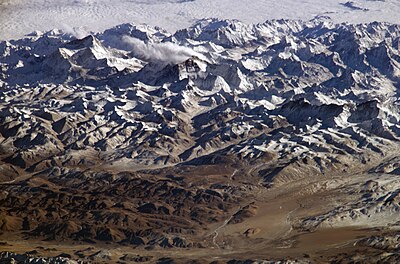| Revision as of 02:55, 30 May 2004 edit62.252.0.4 (talk)No edit summary← Previous edit | Revision as of 06:09, 30 May 2004 edit undoRedWolf (talk | contribs)Autopatrolled, Administrators94,929 editsm manually rolling back previous change to height of Everest - the widely accepted value is 8850 and not 8848mNext edit → | ||
| Line 11: | Line 11: | ||
| The '''Himalayas''' (the '''Himalayan Range''') are a ] in ], separating ] and ] on the south and southwest from the vast ]an plateau (occupied by ]) on the north. ] and ] are sovereign nations in the southern foothills. The Himalayas connect with the ] mountain range in ]. The word Himalaya is of ] origin and means ''abode of snow''. | The '''Himalayas''' (the '''Himalayan Range''') are a ] in ], separating ] and ] on the south and southwest from the vast ]an plateau (occupied by ]) on the north. ] and ] are sovereign nations in the southern foothills. The Himalayas connect with the ] mountain range in ]. The word Himalaya is of ] origin and means ''abode of snow''. | ||
| Many of the world's highest mountains, such as ] ( |
Many of the world's highest mountains, such as ] (8850 m), ] (8611 m) and ] (8598 m) are situated in the Himalayas. | ||
| According to ], the Himalayas are the result of a ] between the ] and ] ]. The continued movement of these plates means the Himalayas are still growing in size. ] believe that the Himalayas would rise at the rate of about 8 to 10 centimeters per year if plate tectonics were the only factor. There are also, however, forces of ] which are wearing the mountains down. The approximate net growth of the Himalayas amounts to 2.5 to 5 centimeters per century. | According to ], the Himalayas are the result of a ] between the ] and ] ]. The continued movement of these plates means the Himalayas are still growing in size. ] believe that the Himalayas would rise at the rate of about 8 to 10 centimeters per year if plate tectonics were the only factor. There are also, however, forces of ] which are wearing the mountains down. The approximate net growth of the Himalayas amounts to 2.5 to 5 centimeters per century. | ||
| Line 27: | Line 27: | ||
| ==Notable individual peaks== | ==Notable individual peaks== | ||
| * ] 8, |
* ] 8,850 m | ||
| * ] 8,611 m | * ] 8,611 m | ||
| * ] 8,586 m | * ] 8,586 m | ||
| Line 46: | Line 46: | ||
| ==See also== | ==See also== | ||
| * ] - a list of Himalayan peaks over 8000 |
* ] - a list of Himalayan peaks over 8000 metres | ||
| * ] | * ] | ||
| * ] | * ] | ||
Revision as of 06:09, 30 May 2004

The Himalayas (the Himalayan Range) are a mountain range in Asia, separating India and Pakistan on the south and southwest from the vast Tibetan plateau (occupied by China) on the north. Nepal and Bhutan are sovereign nations in the southern foothills. The Himalayas connect with the Hindu Kush mountain range in Afghanistan. The word Himalaya is of Sanskrit origin and means abode of snow.
Many of the world's highest mountains, such as Mount Everest (8850 m), K2 (8611 m) and Kanchenjunga (8598 m) are situated in the Himalayas.
According to plate tectonics, the Himalayas are the result of a convergent boundary between the Indo-Australian and Eurasian Plates. The continued movement of these plates means the Himalayas are still growing in size. Geologists believe that the Himalayas would rise at the rate of about 8 to 10 centimeters per year if plate tectonics were the only factor. There are also, however, forces of erosion which are wearing the mountains down. The approximate net growth of the Himalayas amounts to 2.5 to 5 centimeters per century.
Himal
Himal is Nepalese for "range" and is used to name the various regions of the Himalayas. In Nepal, these are as follows:
- Annapurna Himal
- Ganesh Himal
- Khumbu Himal
- Langtang Himal
- Manang Himal
- Rolwaling Himal
Notable individual peaks
- Mount Everest 8,850 m
- K2 8,611 m
- Kangchenjunga 8,586 m
- Lhotse 8,501 m
- Makalu 8,462 m
- Cho Oyu 8,201 m
- Dhaulagiri 8,167 m
- Manaslu 8,163 m
- Nanga Parbat 8,126 m
- Annapurna 8,091 m
- Gasherbrum I 8,068 m
- Broad Peak 8,047 m
- Gasherbrum II 8,035 m
- Shishapangma 8,027 m
- Gyachung Kang7,922 m
- Nanda Devi 7,817 m
- Pumori a popular climbing peak of 7,161 metres.
See also
- Eight-thousander - a list of Himalayan peaks over 8000 metres
- Geography of China
- Trekking peak